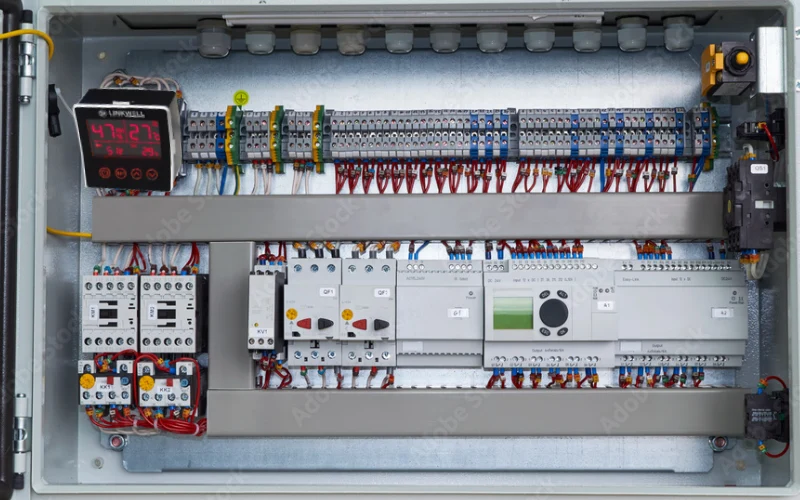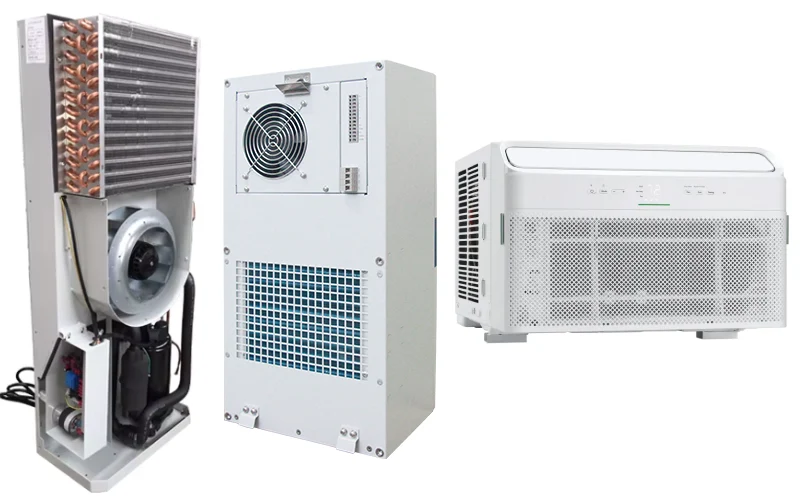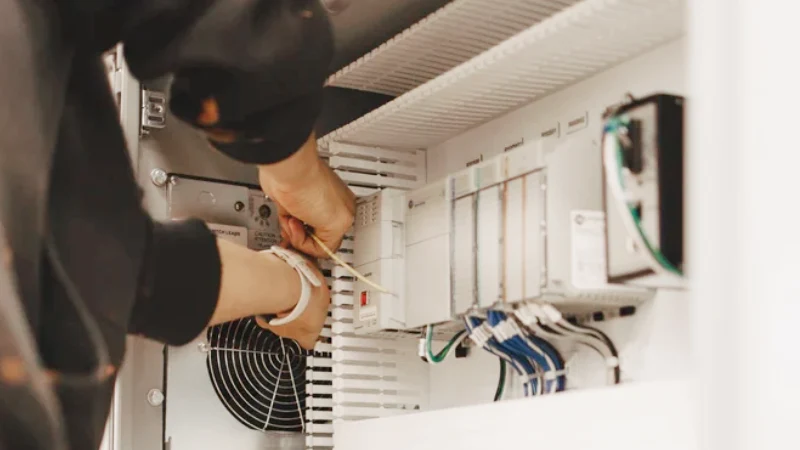Have you ever wondered what is a cable gland and why it matters in your electrical setup? A cable gland is a device that secures and protects cables as they enter electrical enclosures. You rely on cable glands to keep out dust, water, and other hazards, making your system safer and more reliable. Check out the market growth below—these small parts play a big role!
| Attribute | Value |
|---|---|
| Market Size (2024) | USD 1,968.23 Million |
| Market Forecast (2033) | USD 3,134.89 Million |
| CAGR (2025-2033) | 5.04% |
Linkwell stands out as your trusted partner for high-quality cable solutions.
Key Takeaways
- Cable glands secure and protect cables from dust, water, and damage, keeping electrical systems safe and reliable.
- They provide strain relief by holding cables firmly, preventing damage from pulling, twisting, or bending.
- Choosing the right cable gland depends on cable size, material, environment, and required protection level like waterproofing or explosion proofing.
- Different types of cable glands suit various needs, including waterproof, split, explosion proof, plastic, and stainless steel options.
- Proper installation and regular checks ensure cable glands maintain protection and extend the life of your electrical setup.
What is a Cable Gland
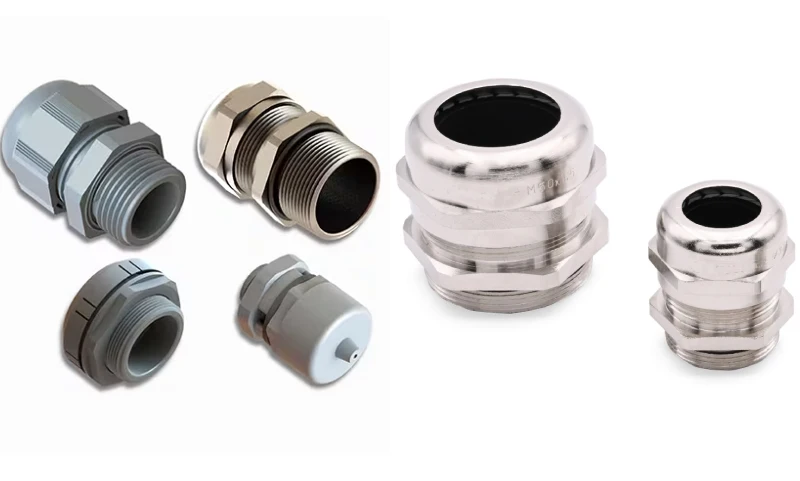
Definition
So, what is a cable gland? You might think of it as a small but mighty device that keeps your electrical systems safe and organized. When you run a cable into an enclosure, you need something to hold it in place and protect it from the outside world. That’s where cable glands come in. They act as the entry point for cables, making sure nothing slips or gets damaged.
You’ll find cable glands made from different materials, each with its own strengths. Here’s a quick look at the most common ones:
| Material | Key Benefits | Typical Use Cases |
|---|---|---|
| Brass | Strong, corrosion-resistant, good conductor | Industrial, outdoor, general use |
| Stainless Steel | Tough, resists chemicals and corrosion | Marine, food processing, harsh sites |
| Aluminum | Lightweight, cost-effective | Light to medium industrial settings |
| Nylon (Polyamide) | Easy to install, chemical/UV resistant | Indoor, moderate environments |
| PVC | Flexible, affordable, good insulation | Light-duty, indoor enclosures |
When you ask, “what is a cable gland used for?” the answer is simple: it’s all about securing and protecting your cables. You’ll see them in control panels, machinery, outdoor lighting, and even in your home’s electrical boxes. If you want to know what is cable gland in electrical setups, just remember—they’re the gatekeepers that keep your wiring safe.
Main Purpose
Let’s dig a little deeper into why cable glands matter so much. You might wonder, “what is the purpose of cable gland?” Here’s what you need to know:
- Securing the Cable: You want your cables to stay put. Cable glands fasten them tightly, so they don’t slip or get pulled out by accident.
- Strain Relief: Cables can get tugged or twisted. Cable glands relieve that strain, stopping damage before it starts.
- Environmental Protection: Dust, water, and chemicals can ruin your electrical connections. Cable glands seal out these threats, keeping your system running smoothly.
- Maintaining Electrical Continuity: Some cable glands help with grounding and shielding, which keeps your system safe from electrical faults.
Tip: Always check the standards before you choose a cable gland. The International Electrotechnical Commission (IEC) sets the main rules, like IEC 60079 for explosive environments and IEC 61892 for offshore setups. These standards make sure your cable glands do their job safely and reliably.
You might also hear questions like, “what size cable gland do I need?” or “what size gland for 1.5 mm cable?” The answer depends on your cable’s diameter and the environment. Picking the right size and material means your cables stay secure and your equipment stays protected.
So, next time you see a control cabinet or a power distribution box, take a closer look. You’ll spot cable glands doing the hard work—keeping everything safe, tidy, and running just the way you want.
Cable Gland Function
Strain Relief
You might wonder why strain relief matters so much when you install cable glands. When you run a cable through a panel or a piece of equipment, you want it to stay secure. If you pull, bend, or twist the cable, you risk damaging the wires inside. That’s where cable glands step in. They grip the cable tightly, holding it in place and absorbing any force that tries to tug or twist it.
Here’s how cable glands provide strain relief in real-world setups:
- You pass the cable through the gland and tighten the dome nut. This compresses a bushing or sealing element around the cable, centering and securing it.
- The gland keeps the cable from being pulled out or cut on sharp edges. You protect the internal contacts and extend the life of your wiring.
- Strain relief absorbs tension, bending, or twisting that could harm the cable or connectors.
- In control cabinets, industrial machines, or even consumer electronics, cable glands stabilize connections and prevent accidental disconnections.
- Dome-style glands use rigid materials like aluminum, brass, steel, or nylon for strong mechanical fixing. Flex-style glands use rubber or flexible plastics to handle continuous motion, perfect for robotics or automotive setups.
If you skip proper strain relief, you risk serious problems. Unsupported cables can sag or stretch, damaging the structure and connectors. Mechanical stress like kinking or bending can break wires, cause signal loss, or even start a fire. You want your system to last, so you need cable glands to distribute mechanical loads and keep everything safe.
Tip: Always check that your cable glands match the type of cable and the environment. This helps you avoid costly repairs and keeps your system running smoothly.
Environmental Protection
Cable glands do more than just hold cables in place. They act as a shield against environmental hazards. You want your electrical connections to stay dry, clean, and safe, especially in tough industrial settings. Cable glands use sealing to block out dust, moisture, and chemicals.
Let’s look at the main hazards cable glands protect against:
| Environmental Hazard | Cause | Protective Role of Cable Glands and Solutions |
|---|---|---|
| Dust and moisture ingress | Poor sealing or incorrect IP rating | Cable glands provide sealing (IP66/IP68) to prevent dust and water ingress into enclosures. |
| Mechanical damage and cable pullout | Vibration, mechanical stress, improper gland size | Cable glands offer strain relief and mechanical protection to prevent cable loosening or damage. |
| Electrical faults due to improper earthing | Lack of earth continuity in armored cables | Metallic cable glands maintain earth continuity to prevent electrical faults and shocks. |
| Explosion hazards in volatile environments | Gas ingress or sparking from poor sealing or fitting | Certified flameproof glands (ATEX, IECEx) prevent explosions by sealing and spark containment. |
| Material degradation and corrosion | Exposure to harsh chemicals and environment | Use of corrosion-resistant materials (stainless steel, nickel-plated) in cable glands protects against degradation. |
You want to keep dust and water out of your enclosures. Cable glands with the right sealing and ingress protection rating make this possible. IP66, IP67, and IP68 are common ratings. IP66 means dust tight and protected against powerful water jets. IP67 means dust tight and protected against temporary immersion. IP68 means dust tight and protected against continuous immersion. You choose the rating based on your environment—whether you face rain, dust storms, or even submersion.
Cable glands also protect against fire risks by reducing the chance of short circuits. They keep cables from twisting or pulling out, which can cause electrical faults. In harsh environments, cable glands use corrosion-resistant materials to fight off chemical attacks. Certified glands, like ATEX or IECEx, seal off explosive gases and prevent sparks.
Note: Proper installation and regular checks help cable glands maintain their sealing and protection over time. You want your system to stay safe and reliable, no matter where you use it.
Types of Cable Glands
Waterproof Cable Gland
You want to keep your electrical connections safe from water, dust, and other hazards. Waterproof cable glands give you that peace of mind. These cable glands use special gaskets and seals to create a watertight barrier. You’ll see them made from brass, plastic, nylon, aluminum, or stainless steel. They’re designed for tough jobs, like marine or industrial sites, where the ip68 waterproof function is critical. Here’s what sets them apart:
- Watertight sealing keeps moisture and contaminants out.
- Durable materials stand up to harsh environments.
- Integrated gaskets maintain protection, even during long-term water immersion.
- IP ratings like IP65, IP66, IP67, and IP68 show how well they block solids and liquids.
- Extra features can include explosion-proofing, flame resistance, and UV stability.
If you need the ip68 waterproof function, these cable glands are your go-to choice.
Split Cable Gland
Split cable glands make your life easier when you work with pre-terminated cables or harnesses. You don’t have to cut off connectors or modify anything. You just open the gland, route your cable, and close it up. This keeps warranties intact and speeds up assembly. Split cable glands offer secure entry points, strain relief, and sealing against dust and moisture. You’ll find them in control panels, machinery, and places where maintenance needs to be quick and simple. The ip68 waterproof function is often available, so you get top protection.
Tip: Split cable glands are perfect for industrial, food, and pharmaceutical setups where hygiene and easy maintenance matter.
Explosion Proof Cable Gland
If you work in hazardous environments, explosion proof cable glands are a must. These cable glands carry ATEX and IECEx certifications, which means they meet strict safety standards for explosive atmospheres. You’ll see markings like CE and Ex, showing compliance with IEC 60079 standards. Explosion proof cable glands use robust sealing and construction to prevent sparks and gas leaks. They’re built for tough zones, like oil and gas, chemical plants, and mining.
Plastic Cable Glands
Plastic cable glands, especially nylon types, offer great insulation and waterproofing. You get easy installation without special tools. They’re affordable and ideal for less demanding environments. Here’s a quick look:
- Protect wiring from environmental hazards
- Provide IP-rated water ingress protection
- Offer strain relief against twisting and pulling
| Aspect | Plastic (Nylon) Cable Glands | Metal Cable Glands |
|---|---|---|
| Installation | Quick, easy | Needs tools |
| Cost | Low | High |
| Insulation | Excellent | Good |
| Suitability | Indoor, frequent movement | Harsh, outdoor |
| Maintenance | Simple | More checks |
| Waterproof & Strain Relief | Yes | Yes |
Stainless Steel Cable Gland
You want maximum corrosion resistance? Stainless steel cable glands deliver. They resist water, dust, salt, acids, and oils. Grades like AISI 304 and 316 last 20-30 years with little maintenance. These cable glands are perfect for marine, nuclear, and pharmaceutical industries. The ip68 waterproof function is standard, so you get reliable sealing in the harshest conditions.
Metallic
Metallic cable glands give you strength and durability. They handle high temperatures, crushing, and chemical exposure. You get electromagnetic compatibility (EMC) shielding, which is important for industrial and outdoor setups. These cable glands resist impact and last longer, but they’re heavier and may need grounding.
Non-Metallic
Non-metallic cable glands, usually made from nylon or plastic, are lightweight and corrosion-resistant. You’ll find them in indoor or non-hazardous areas. They’re easy to install and cost-effective. You get good electrical insulation, but less mechanical strength and no EMC shielding. These cable glands work best where you don’t need heavy-duty protection.
Cable Glands in Industry
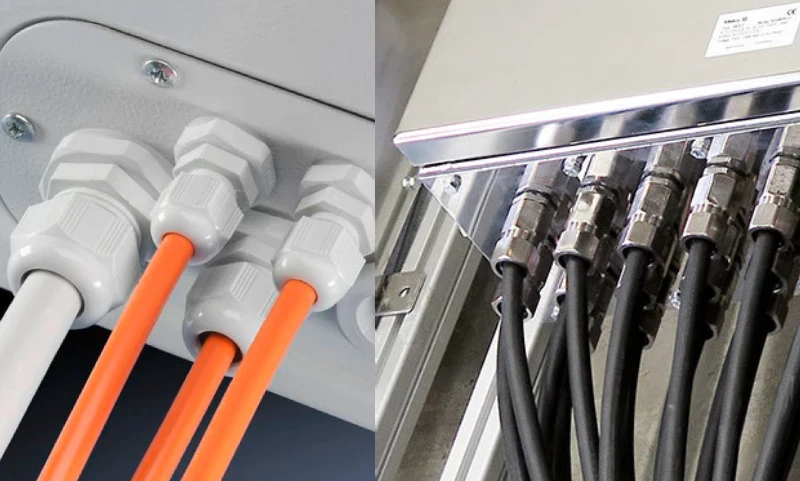
Applications
You see cable glands everywhere in tough industrial environments. They protect cables in places where dust, moisture, and chemicals threaten your electrical systems. You find them in automatic assembly lines, oil and gas plants, rail transit, and marine setups. Aerospace and manufacturing facilities rely on cable glands to keep connections secure. Power utilities and telecommunications use them for safe cable entry in outdoor and indoor Electrical Enclosure installations.
- You use cable glands in offshore and onshore locations exposed to rain, salt water, and corrosive elements.
- They work in hazardous and explosive atmospheres, meeting safety certifications like ATEX and IECEx.
- You see cable glands in low, medium, and high voltage systems, handling armored and unarmored cables.
- Food and beverage industries trust cable glands for clean, waterproof cable connections.
Cable glands provide mechanical support, earth continuity, and environmental protection. You want your cables to stay safe from moisture, dust, corrosion, and mechanical strain. When you ask what are cable glands used for, think about every place where cables need to enter an enclosure and stay protected.
Tip: Always check the material and certification of your cable glands before installing them in harsh environments.
Linkwell Solutions
You want reliable cable management in your data center, control cabinet, or industrial workspace. Linkwell offers solutions that make your job easier and safer. Their rack cable management systems help you organize cables, optimize airflow, and reduce clutter. You get horizontal and vertical cable managers, cable ties, and labeling systems designed for easy access and protection.
Linkwell’s electrical power distribution box keeps your circuits safe from overloads and short circuits. You install these boxes in factories, telecom cabinets, and outdoor enclosures. They come with pre-cut cable entries and labeled terminals, making installation quick and error-free.
Here’s a quick look at Linkwell’s cable management features:
| Feature | Specification | Application Scenario |
|---|---|---|
| Material | Rigid PVC Plastic | Harsh industrial environments |
| Dimensions | 100x100mm | Industrial, commercial, IT setups |
| Certification | CE Certified | EU safety compliance |
| Design | Slotted Modular Design | Cable routing and organization |
| Mounting | Pre-drilled holes | Wall or rack mounting in factories |
| Modular Construction | Interlocking sections | Scalable cable management systems |
You get scalable, customizable solutions that fit your project needs. Linkwell’s products support cable glands by providing secure entry points and organized pathways for every cable in your system. You keep your workspace safe, tidy, and ready for future upgrades.
Choosing Cable Glands
Key Factors
When you start a cable gland installation, you want to get it right the first time. Picking the right cable gland means your system stays safe, reliable, and easy to maintain. Here’s what you should look for:
- Check your cable type and diameter. You need a cable gland that fits snugly, so measure carefully before installation.
- Think about the environment. Will your cables face water, dust, chemicals, or extreme temperatures? Choose materials like stainless steel for harsh areas or plastic for indoor, low-stress spots.
- Look at the IP or NEMA rating. If you need water resistance, go for IP68 or higher. This keeps your cable gland installation protected from dust and moisture.
- Make sure the gland matches your cable’s construction—armored, shielded, or flexible. Each type needs a specific design for proper installation.
- Confirm certifications like UL, CE, or ATEX. These show your cable gland installation meets safety and performance standards.
- Don’t forget mechanical needs. Strain relief is key to prevent cable damage during installation and use.
- Match the gland material to your cable and enclosure. This avoids corrosion and ensures a long-lasting installation.
Tip: Always double-check the thread size and type before starting your cable gland installation. This small step saves you from big headaches later.
Linkwell Recommendations
You want a cable gland installation that lasts. Linkwell makes it easy by offering solutions tailored to your needs. You can pick from a range of sizes for small, medium, or large cable bundles. If you need a special design for a control cabinet or outdoor telecom box, Linkwell can customize it. You even get branding options, like your company logo molded onto the entry plate.
Linkwell uses industrial-grade materials tested for heat, UV, and chemical resistance. You can choose sealing grades from IP54 to IP68, so your cable gland installation stands up to any challenge. Modular configurations help you save space and speed up installation.
Linkwell’s products meet or exceed industry standards. You get peace of mind knowing your cable gland installation is safe, durable, and compliant. The company’s experience with Fortune 500 clients and OEM capabilities means you get reliable support for every installation.
| Common Mistake | How to Avoid It |
|---|---|
| Incorrect component size | Use manufacturer tables for exact cable fit |
| Over/under-tightening | Follow torque specs for secure installation |
| Poor material choice | Pick materials rated for your environment |
| Skipping maintenance | Inspect and replace seals during regular installation checks |
Remember: A good cable gland installation saves you money in the long run by reducing downtime and maintenance.
You now know what is a cable gland and why it matters in every electrical setup. Let’s recap the essentials:
- Cable glands protect your cables from damage, dust, and moisture, keeping your system safe and reliable.
- They offer strain relief, prevent cable pull-out, and help maintain electrical integrity.
- You can find cable glands in all kinds of environments—industrial, commercial, and even hazardous zones.
When you want dependable cable management, Linkwell stands out. Their products meet strict industry standards and come with expert support. If you need reliable cable glands or electrical components, you can trust Linkwell to help your project succeed.
FAQ
What is cable gland in electrical systems?
You use a cable gland to secure and protect cables entering electrical enclosures. It keeps dust, water, and other hazards out. You get a safer and more reliable setup for your wiring.
What size cable gland do I need for my cable?
You pick the cable gland size based on your cable’s diameter. For example, if you have a 1.5 mm cable, check manufacturer tables to find the right gland size. Always measure before you buy.
What is double compression cable gland?
You use a double compression cable gland for extra sealing and strain relief. It has two compression points, so it works well in outdoor or industrial environments. You get better protection against moisture and dust.
What is EMC cable gland?
You choose an EMC cable gland when you need electromagnetic compatibility. It blocks electrical interference, so your signals stay clear. You use it in data centers, control cabinets, and sensitive equipment.
What is cable glanding and termination?
You install a cable gland to secure the cable, then terminate the wires inside the enclosure. This process keeps your connections safe, organized, and protected from environmental hazards.

